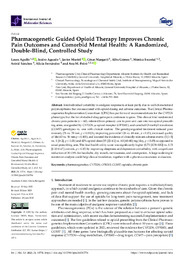Por favor, use este identificador para citar o enlazar este ítem:
https://hdl.handle.net/11000/31404Registro completo de metadatos
| Campo DC | Valor | Lengua/Idioma |
|---|---|---|
| dc.contributor.author | Agulló, Laura | - |
| dc.contributor.author | Aguado, Isidro | - |
| dc.contributor.author | Muriel, Javier | - |
| dc.contributor.author | Margarit, César | - |
| dc.contributor.author | Gómez, Alba | - |
| dc.contributor.author | Escorial, Mónica | - |
| dc.contributor.author | Sánchez, Astrid | - |
| dc.contributor.author | Fernández, Alicia | - |
| dc.contributor.author | Peiró Peiró, Ana M. | - |
| dc.contributor.other | Departamentos de la UMH::Farmacología, Pediatría y Química Orgánica | es_ES |
| dc.date.accessioned | 2024-02-09T16:35:15Z | - |
| dc.date.available | 2024-02-09T16:35:15Z | - |
| dc.date.created | 2023 | - |
| dc.identifier.citation | International Journal of Molecular Sciences . 2023 Jun 28;24(13):10754 | es_ES |
| dc.identifier.issn | 1422-0067 | - |
| dc.identifier.uri | https://hdl.handle.net/11000/31404 | - |
| dc.description.abstract | Interindividual variability in analgesic response is at least partly due to well-characterized polymorphisms that are associated with opioid dosing and adverse outcomes. The Clinical Pharmacogenetics Implementation Consortium (CPIC) has put forward recommendations for the CYP2D6 phenotype, but the list of studied drug-gene pairs continues to grow. This clinical trial randomized chronic pain patients (n = 60), referred from primary care to pain unit care into two opioid prescribing arms, one guided by CYP2D6, μ-opioid receptor (OPRM1), and catechol-O-methyl transferase (COMT) genotypes vs. one with clinical routine. The genotype-guided treatment reduced pain intensity (76 vs. 59 mm, p < 0.01) by improving pain relief (28 vs. 48 mm, p < 0.05), increased quality of life (43 vs. 56 mm p < 0.001), and lowered the incidence of clinically relevant adverse events (3 [1-5] vs. 1 [0-2], p < 0.01) and 42% opioid dose (35 [22-61] vs. 60 [40-80] mg/day, p < 0.05) as opposed to usual prescribing arm. The final health utility score was significantly higher (0.71 [0.58-0.82] vs. 0.51 [0.13-0.67] controls, p < 0.05) by improving sleepiness and depression comorbidity, with a significant reduction of 30-34% for headache, dry mouth, nervousness, and constipation. A large-scale implementation analysis could help clinical translation, together with a pharmaco-economic evaluation. | es_ES |
| dc.format | application/pdf | es_ES |
| dc.format.extent | 15 | es_ES |
| dc.language.iso | eng | es_ES |
| dc.publisher | MDPI | es_ES |
| dc.rights | info:eu-repo/semantics/openAccess | es_ES |
| dc.rights | Attribution-NonCommercial-NoDerivatives 4.0 Internacional | * |
| dc.rights.uri | http://creativecommons.org/licenses/by-nc-nd/4.0/ | * |
| dc.subject | pharmacogenetics | es_ES |
| dc.subject | CYP2D6 | es_ES |
| dc.subject | OPRM1 | es_ES |
| dc.subject | COMT | es_ES |
| dc.subject | opioids | es_ES |
| dc.subject | chronic pain | es_ES |
| dc.title | Pharmacogenetic Guided Opioid Therapy Improves Chronic Pain Outcomes and Comorbid Mental Health: A Randomized, Double-Blind, Controlled Study | es_ES |
| dc.type | info:eu-repo/semantics/article | es_ES |
| dc.contributor.institute | Institutos de la UMH::Instituto de Bioingeniería | es_ES |
| dc.relation.publisherversion | 10.3390/ijms241310754. | es_ES |

Ver/Abrir:
Pharmacogenetic Guided Opioid Therapy Improves Chronic.pdf
1,35 MB
Adobe PDF
Compartir:
 La licencia se describe como: Atribución-NonComercial-NoDerivada 4.0 Internacional.
La licencia se describe como: Atribución-NonComercial-NoDerivada 4.0 Internacional.
.png)